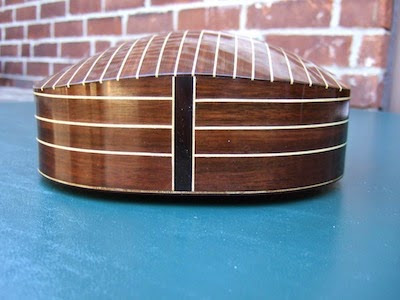I finished the small baroque terz guitar that was the subject of my post from January 2, 2015. The design is my own creation but it is solidly based on guitars by Matteo Sellas. I analyzed four guitars made by members of the Sellas family in the first half of the 17th century and used my findings to arrive at a final design. That post includes several schematic drawings.
The construction of this guitar follows techniques and procedures that I have described in other posts so this is mostly a photo essay.
The length of the body is 372mm to the neck joint.
The upper bout is 160mm wide while the waist is 142mm and the lower bout is 201mm. The open rose diameter is 64mm and it is positioned at 67% of the body length.
The design of the flourishes of the bridge is inspired by the Matteo Sellas guitar in the Metropolitan Museum of Art, New York.
The core of the neck is poplar veneered with Kingwood strips separated by holly. The heel sits in a recess in the front block of the guitar. Italian baroque guitars are usually glued right to the front of the body. The rear surface of the heel is contoured to fit the curvature. A nail is then driven through the block and heel and into the neck. This is done before the soundboard is attached. I've built many guitars in this manner. Sometime in the 18th century makers started to fit the heel into a recess in the front block - probably in an attempt to counteract the demand for increased string tension. I use this method on 19th century guitars and I wanted a sturdier joint so I used it here. Also, the soundboard can be glued in place first, meaning any slight adjustment in the angle of the neck, if necessary, can be easily made.
The peg head is fitted to the neck with a full width V-joint. The neck is not curved across its width. The two edge pieces of veneer are flat. This style is sometimes found on baroque guitars. Using this style of neck solves the principal problem associated with a V-joint, namely, how to blend two dissimilar surfaces - the flat peg head and the curved neck into one joint without leaving part of the neck end exposed.
The peghead angle is about 11 degrees and is tapered in thickness. The core wood is American Walnut, capped both sides with African Blackwood.
The maximum depth of the body is 93mm while the maximum rib depth is 76mm at the waist, 58mm at the tail and 45mm at the neck joint.
The finish on all of the hardwood parts, except the fingerboard, bridge and pegs is French polish made with blond shellac flakes applied in the traditional manner. The finish on the soundboard is multiple applications of tung oil finished with beeswax.
All photos by the author.










